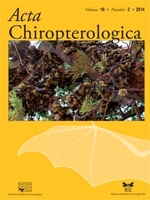The use of different roost types by Daubenton's bats (Myotis daubentonii) during reproduction was investigated in two adjacent river valleys in northeastern Scotland. Forty-six individuals from six colonies were radiotracked during the summers of 2004–2006. The frequency of roost switching varied with reproductive status, and was lowest in lactating females and highest in non-reproductive females, which changed roosts on average once every 5.0 and 1.5 days, respectively. Although Daubenton's bats regularly switched roosts, strong faithfulness to the roosting area was apparent regardless of whether they formed maternity colonies in trees or buildings. Although most roosts found at both study areas were in trees, lactating females and juveniles in one valley roosted only in trees whereas in the other they roosted exclusively in buildings, in which ambient temperatures were significantly higher. The implications of roosting habits for the transmission of European bat lyssavirus are discussed.
How to translate text using browser tools
1 December 2014
Roosting Habits of Daubenton's Bat (Myotis daubentonii) during Reproduction Differs between Adjacent River Valleys
Thongchai Ngamprasertwong,
Stuart B. Piertney,
Iain Mackie,
Paul A. Racey
ACCESS THE FULL ARTICLE

Acta Chiropterologica
Vol. 16 • No. 2
December 2014
Vol. 16 • No. 2
December 2014
Daubenton's bat
EBLV2
Myotis daubentonii
reproduction
roost switching
roosting behaviour




